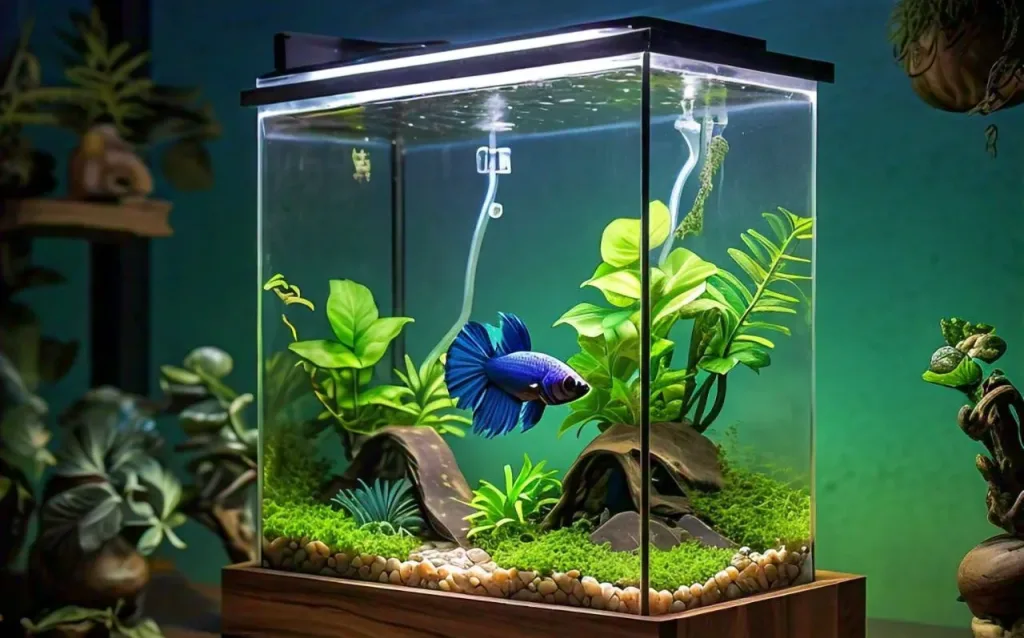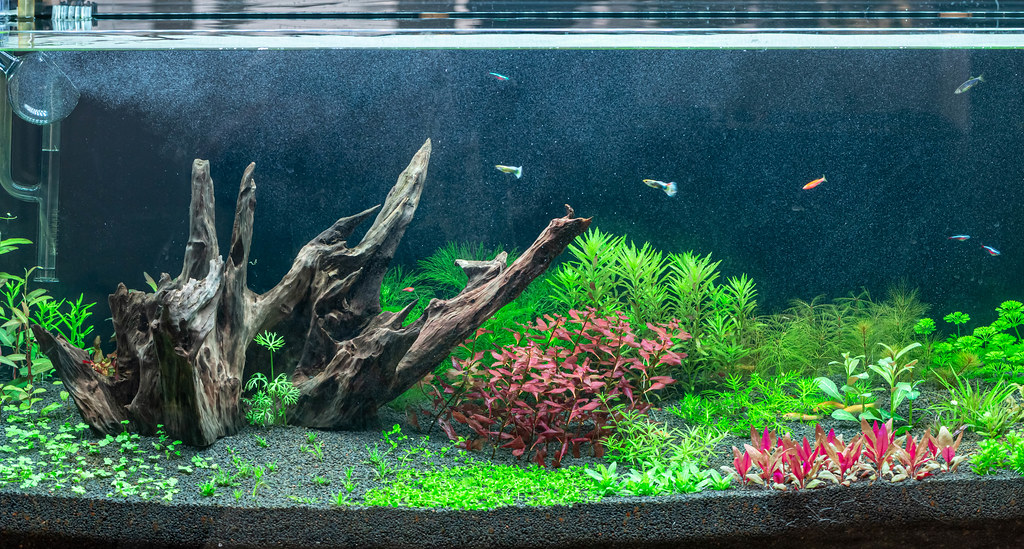Plants enhance the tank’s appearance but also help improve water quality by absorbing toxins and providing hiding spots for your fish.
- Java Fern
- Anubias Marimo
- Moss Ball Amazon Sword
- Amazon Sword
- Water Sprite
- Cryptocoryne
Fake Plants For Betta Fish
Here are some popular types of fake plants for betta fish that are safe and great for tanks:
- Silk plants are soft and gentle, making them safe for Betta fins. They look more natural and move like real plants in water.
- Some plastic plants are designed with smooth, rounded edges to prevent tearing the Betta’s delicate fins. Always check the texture before placing them in the tank.
- Moss Balls (Imitation) are fake versions of real moss balls that give a natural look and provide hiding spots for Bettas.
- Anubias Imitation is a popular real plant for fish tanks, and there are fake versions that mimic its wide, sturdy leaves. Betta fish love resting on these.
These types of fake plants are easy to maintain, safe for your Betta, and can create a beautiful environment in the tank.
The Best Leaves For Betta
Betta fish enjoy having leaves in their tanks for hiding, resting, and exploring. When using leaves, always make sure they are dried and free from pesticides or chemicals. Avoid leaves from trees that might be toxic to fish, such as pine or maple.
Here are some of the best types of leaves you can use:
Almond Leaves (Catappa Leaves)
These are popular because they release natural tannins that help lower the pH of the water and create a calming, tea-colored environment.
Banana Leaves
Banana leaves also release beneficial tannins and are a great choice for creating a natural, soft environment for your betta.
Guava Leaves
Known for their antibacterial properties, guava leaves help prevent infections in betta fish.
Mulberry Leaves
Mulberry leaves are another safe option that releases tannins and provides shelter for your betta.
How to Set Up a Betta Tank with Live Plants

- Pick a Tank betta fish need at least 5 gallons of water to thrive.
- Use aquarium gravel or substrate that supports plant growth.
- Add live plants place them in the gravel or attach them to decorations like rocks or driftwood.
- Install a filter and a heater bettas like warm water (around 78-80°F).
- Let the tank cycle for a few days before adding your betta. This allows the plants to settle and the water to become safe for your fish.
Toxic Plants For Betta Fish
Dieffenbachia (Dumb Cane)
This plant contains a sap that can irritate a betta’s skin and gills.
Philodendron
While popular in homes, philodendrons release chemicals that can poison your betta when submerged in water.
Peace Lily
Its roots may release harmful substances into the water, leading to stress or illness for your fish.
Caladium
This plant contains calcium oxalate crystals that are harmful to betta fish. If ingested or if the plant decays in water, it can cause serious health problems.
Aloe Vera
Aloe vera is often used in aquariums for its healing properties, but in high amounts, it can become toxic to bettas. Be cautious with any aloe-based products or plants.
By avoiding these harmful plants, you can keep your betta healthy and happy in their home!
Can Betta Fish Eat Plants?
They don’t eat them for food. They are carnivores, so they mainly need protein-rich foods like insects, larvae, or special betta pellets while they may occasionally bite at leaves, it’s more out of curiosity or to clean their space rather than for nutrition.
Plants For Betta Fish
Java Fern:
Acts like a natural filter, absorbing excess nutrients and releasing oxygen, which keeps the tank environment healthy.
Anubias
Anubias plants are great for betta fish tanks because they’re tough and don’t need a lot of light. Their big leaves give bettas comfy spots to rest on, which helps keep them happy.
Pogostemon Stellatus ‘Octopus’
The leaves can turn from green to reddish under good lighting, making your aquarium more vibrant.
Sword Plant
A sword plant usually means a plant from the Echinodorus group, commonly called Amazon sword plants.
Water Sprite (Ceratopteris thalictroides)
Water sprite is a well-loved plant for freshwater aquariums. Its delicate, feathery leaves and ability to thrive in various water conditions make it a popular choice.
Driftwood
It’s wood that has been floating around in water, like rivers or oceans, and then ends up washed ashore.
Floating Plants
1: They provide shade, which helps reduce algae growth.
2: They absorb nutrients from the water, helping to keep it clean and clear.
3: They offer hiding spots for fish making them feel safe.
FAQs
- Do Aquarium Plants Improve Water Quality?
Yes, live plants make water quality better. They absorb harmful substances like ammonia, nitrites, and nitrates from fish waste and leftover food. Plants also add oxygen to the water, which is good for fish, and they help keep the pH level stable.
- Do Live Plants Make a Fish Tank Dirty?
No, live plants don’t make the tank dirty. They help clean the water by using waste products. However, you need to remove dead plant parts so they don’t decay and add to the waste.
- Is Rice Water Good for Plants?
Yes, rice water can be good for plants. It has nutrients that help plants grow. Use it sparingly because too much can attract pests or cause mold.
Conclusion
Adding plants to your betta fish tank enhances its beauty, improves water quality, and creates a safe, natural environment for your fish. Opt for safe live plants like Java Fern, Anubias, or Amazon Sword, or choose silk or smooth-edged plastic plants for easy maintenance. Avoid toxic plants such as Dieffenbachia or Philodendron to protect your betta’s health. By selecting the right plants and maintaining a balanced ecosystem, you can ensure your betta thrives in a clean, healthy, and visually stunning habitat.

1 thought on “Top Picks For Your Aquarium, Betta Fish Love These Plants.”